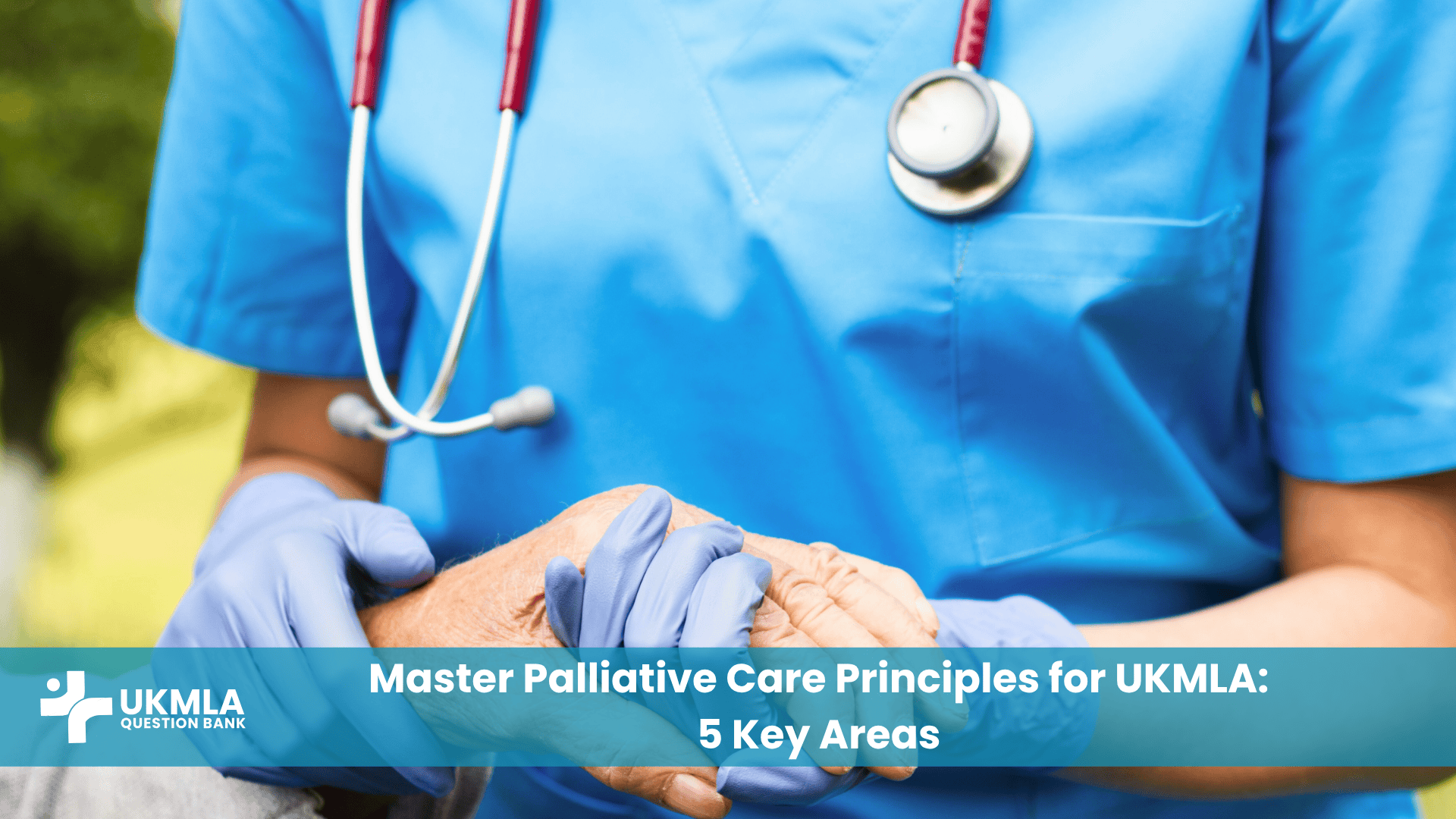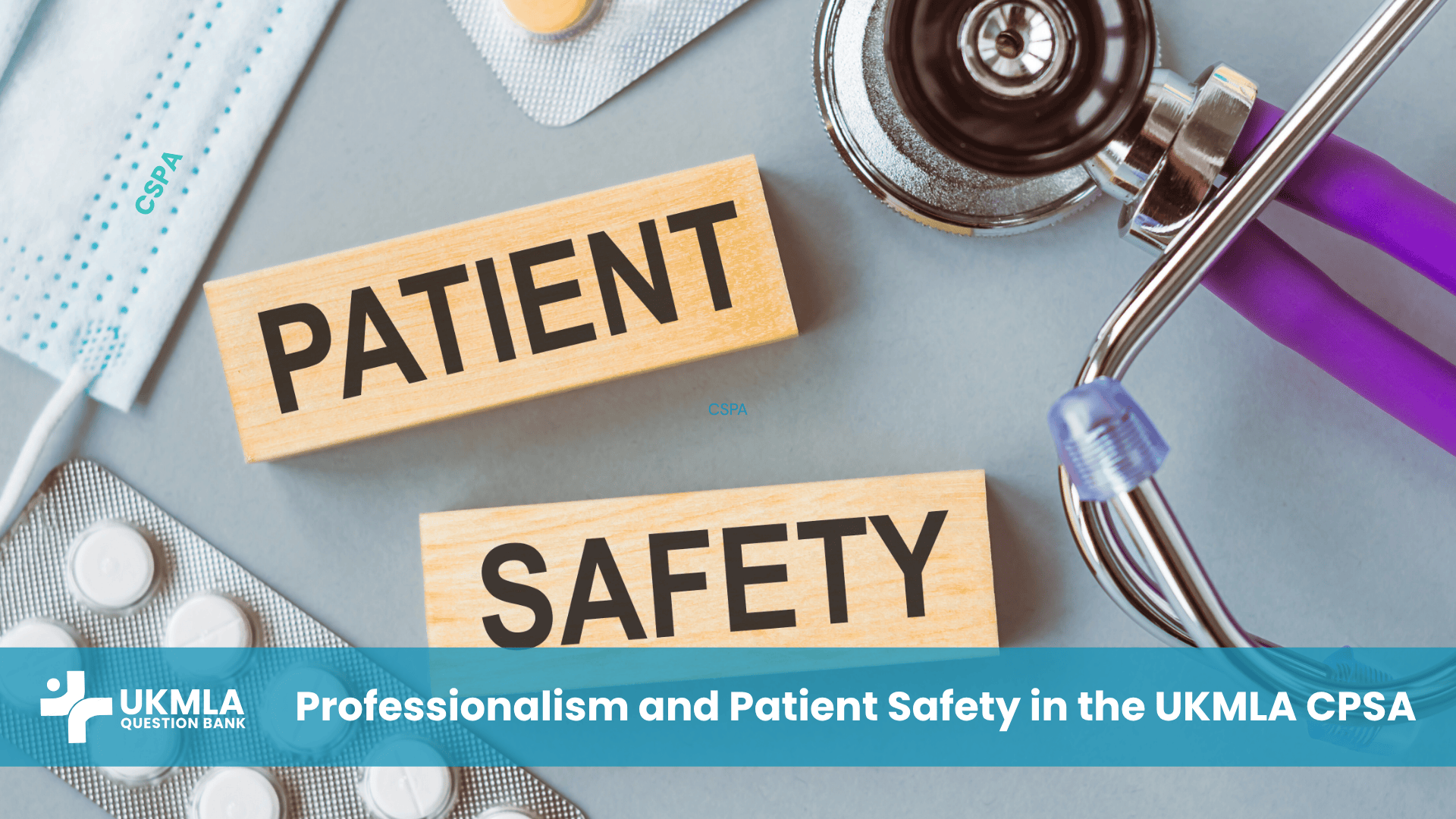Introduction
Mastering the core palliative care principles for UKMLA is essential for any medical student preparing for the AKT and for their future as a compassionate doctor. Palliative care is often misunderstood as being solely for patients in their last days of life. In reality, it is a holistic and active approach to care that aims to improve the quality of life for patients and their families facing any serious or life-limiting illness, at any stage of their disease.
The UK Medical Licensing Assessment (UKMLA) will test your ability to apply these principles in complex, nuanced scenarios. It assesses your capacity for expert symptom management, clear communication, and sound ethical reasoning. This guide is designed to provide a clear framework, breaking this broad topic down into 5 key areas you must master to confidently navigate these questions and provide excellent care to your future patients.
Key Takeaways
Adopt a Holistic Approach: Palliative care focuses on improving a patient’s overall quality of life by addressing physical, psychological, social, and spiritual needs—the concept of “total pain.” It is not just for the last days of life.
Master Core Symptom Management: Be an expert in applying the WHO analgesic ladder for pain, understand the cause-based approach to choosing antiemetics, and know the role of low-dose opioids in managing refractory breathlessness.
Use Frameworks for Difficult Conversations: Communication is a core clinical skill. Use structured methods like the SPIKES protocol for breaking bad news and be prepared to honestly and sensitively discuss prognosis by focusing on patient priorities rather than exact timelines.
Prioritize End-of-Life Planning: Understand the importance of Advance Care Planning (ACP) to respect patient wishes and know the purpose of anticipatory prescribing (the “just in case” box) for managing symptoms at home in the last days of life.
Anchor Decisions in Ethical & Legal Principles: All actions, especially regarding capacity, consent, and DNACPR, must be defensible and guided by the GMC’s “Good Medical Practice” and relevant legislation like the Mental Capacity Act. This is the standard you are tested against.
The 5 Key Areas of Palliative Care Principles for UKMLA
To succeed, you must approach this topic systematically. These five key areas cover the breadth of knowledge and skills required for the UKMLA AKT.
1: The Core Philosophy & Holistic Assessment
This first area is about understanding the ‘what’ and ‘why’ of palliative care. It’s a fundamental mindset shift from purely curative treatment to a focus on quality of life.
The WHO Definition: The World Health Organization defines palliative care as an approach that improves the quality of life of patients and their families facing problems associated with life-threatening illness. It focuses on the prevention and relief of suffering through early identification, assessment, and treatment of pain and other problems—physical, psychosocial, and spiritual.
Holistic Assessment: This means looking beyond the disease. A holistic assessment addresses the “total pain” a patient may be experiencing. This includes:
Physical: The pain, nausea, or breathlessness caused by the illness.
Psychological: The patient’s fears, anxieties, or depression related to their diagnosis.
Social: The impact on their family, finances, or housing.
Spiritual/Existential: The patient’s search for meaning, their values, and their questions about life and death.
The Multidisciplinary Team (MDT): No single person can manage all these needs. Good palliative care relies on an MDT, which may include doctors, specialist nurses, physiotherapists, occupational therapists, social workers, and chaplains.
2: Expert Symptom Management
This is the practical, hands-on pillar of palliative medicine. Your ability to safely and effectively manage distressing symptoms is a core competency.
Table 1: The WHO Analgesic Ladder in Palliative Care
| Step | Type of Pain | Recommended Analgesia | Key Considerations |
|---|---|---|---|
| Step 1 | Mild Pain | Non-opioid +/- Adjuvant | Use Paracetamol and/or NSAIDs regularly. |
| Step 2 | Moderate Pain | Weak Opioid + Non-opioid +/- Adjuvant | Introduce drugs like Codeine or Tramadol. Watch for constipation. |
| Step 3 | Severe Pain | Strong Opioid + Non-opioid +/- Adjuvant | Introduce drugs like Morphine or Oxycodone. Start low, go slow. |
Beyond pain, you must know how to manage other common symptoms:
Nausea & Vomiting: The key is to identify the likely cause to guide your choice of antiemetic. For example, use Metoclopramide for gastric stasis, Cyclizine for visceral or vestibular causes, and Levomepromazine for more complex, refractory nausea.
Breathlessness: Initial management focuses on non-pharmacological measures like using a fan, managing anxiety, and proper positioning. For refractory breathlessness, low-dose oral or subcutaneous opioids (like morphine) are highly effective.
Agitation & Delirium: Always look for and treat reversible causes first (e.g., infection, constipation, electrolyte imbalance). If the patient remains distressed, small doses of an antipsychotic like Haloperidol may be used.
For more detail on the medications used, refer to our essential guide on high-yield pharmacology for UKMLA.
3: Communication in Difficult Circumstances
Communication is not a “soft skill” in palliative care; it is a core clinical procedure that is heavily tested.
Breaking Bad News: You should be familiar with a structured approach like the SPIKES protocol:
Setting up the interview
Perception: assessing the patient’s perception
Invitation: obtaining the patient’s invitation to share information
Knowledge: giving knowledge and information
Emotions: addressing the patient’s emotions with empathic responses
Strategy and Summary
Handling Difficult Questions: Be prepared for questions like “How long do I have left, doctor?”. A sensitive and honest approach is key. Avoid giving specific timeframes; instead, talk in ranges and focus on hopes and priorities. A good response might be: “It is very difficult to be precise, and I can’t give you an exact number. It could be a matter of weeks to a few months. My priority is to make sure you are as comfortable as possible so you can focus on what is most important to you.”
4: End-of-Life Care & Planning
This area deals with the specific management of a patient in their last days or weeks of life.
Recognising Dying: This is a clinical skill. Look for signs like profound weakness, reduced oral intake, drowsiness, and changes in breathing patterns (e.g., Cheyne-Stokes respiration).
Advance Care Planning (ACP): This is the process of discussing a patient’s wishes and preferences for their future care. It can lead to formal documents but is primarily about the conversation itself.
Anticipatory Prescribing: This involves prescribing a small supply of “just in case” medications for common symptoms at the end of life, left in the patient’s home for community nurses to administer. This typically includes medications for pain (opioid), agitation (midazolam), nausea (antiemetic), and respiratory secretions (e.g., glycopyrronium).
5: Ethical and Legal Considerations
Navigating the ethical and legal landscape at the end of life is a key professional skill. The cornerstone of UK practice is the GMC’s guidance, “Treatment and care towards the end of life.”
From the General Medical Council (GMC): “You must presume that every adult patient has the capacity to make decisions about their treatment and care. You must not assume that a patient lacks capacity to make a decision solely because of their age, disability, or any other characteristic.”
Key topics for the UKMLA include:
DNACPR Decisions: Understand that a “Do Not Attempt Cardiopulmonary Resuscitation” decision is about avoiding a burdensome, invasive, and likely futile medical intervention. It is not about “withdrawing care.”
Advance Decisions to Refuse Treatment (ADRT): A legally binding document (if valid and applicable) made by a patient with capacity, which must be respected even if it means the patient will die.
The Doctrine of Double Effect: This principle states that it is ethically permissible to give a treatment (like high-dose morphine) with the primary intention of relieving suffering, even if there is a foreseeable but unintended secondary effect of hastening death. This is distinct from euthanasia, which is illegal in the UK.
For a deeper dive into these concepts, refer to our guide on Medical Ethics and Law for UKMLA.
Applying Palliative Principles to UKMLA SBAs
SBA (Single Best Answer) questions in palliative care test your ability to apply these principles.
Deconstruct the Vignette: First, identify the core issues. Is this a symptom control problem, a communication challenge, or an ethical dilemma? What are the patient’s stated wishes and fears?
Identify the Core Conflict: Often, the question will present a conflict, for example, between a patient’s wish to go home and their complex care needs, or between a family’s desire for aggressive treatment and the clinical reality of futility.
Choose the Most Compassionate and Appropriate Option: The correct answer is usually the one that prioritises the patient’s comfort, dignity, and autonomy while adhering to GMC guidance. This often involves clear communication, involving the MDT, or managing a symptom effectively.
Frequently Asked Questions (FAQ): UKMLA Palliative Care
Palliative care is an approach to care that can be provided at any stage of a serious illness, even alongside curative treatment. Hospice care is a model of care specifically for patients who are approaching the end of their lives, where the focus has shifted entirely to comfort and quality of life.
You should know the common conversion ratios, especially for oral morphine to other opioids. For example, oral morphine is approximately twice as potent as oral codeine. The conversion from oral morphine to subcutaneous morphine is typically 2:1 (e.g., 30mg oral morphine is roughly equivalent to 15mg subcutaneous morphine over 24 hours).
A syringe driver (or pump) is a small, portable, battery-operated device that delivers continuous subcutaneous infusions of medication over 24 hours. It is used at the end of life when a patient can no longer take oral medications, allowing for smooth control of pain, nausea, and agitation.
It’s a decision-making process outlined in the Mental Capacity Act. It involves considering the patient’s previously expressed wishes, their beliefs and values, and the views of their family or anyone with Lasting Power of Attorney, and weighing the benefits and burdens of a proposed treatment.
No. Truth-telling and honesty are fundamental principles. While information should be delivered sensitively and with compassion, withholding information or being dishonest undermines patient autonomy and trust.
The professional Duty of Candour means being open and honest with patients and families when things go wrong. In a palliative setting, this also extends to being honest about prognosis and the limitations of treatment, even when it is difficult news to deliver.
This is a classic ethical conflict. The first step is always communication: arrange a meeting with the family (and the patient, if able) with senior medical staff and potentially the palliative care team. The goal is to explore their fears and goals, explain the clinical reasoning behind why a treatment is considered futile, and find a shared understanding focused on the patient’s comfort and dignity.
Yes. A patient with capacity has the right to refuse any treatment, and this includes clinically assisted nutrition and hydration. At the very end of life, the sensation of hunger and thirst often diminishes, and providing fluids can sometimes cause more distress.
The principles are the same, but the illness trajectory can be different. Patients with conditions like advanced heart failure, COPD, or dementia may have a less predictable decline, with periods of stability and sudden deterioration. This makes Advance Care Planning even more important.
Understand the core principles in this guide and then apply them. Use a high-quality UKMLA question bank to work through dozens of SBAs on palliative care, ethics, and communication to see how these concepts are tested in practice.
Conclusion & Call to Action (CTA)
Mastering the core palliative care principles for UKMLA is fundamentally about learning to be a good doctor. It’s about combining clinical knowledge of symptom management with compassionate communication and robust ethical reasoning. By focusing on the 5 key areas—the holistic philosophy, symptom control, communication, end-of-life planning, and ethics—you can build a confident and competent approach.
Remember that every SBA in this domain is testing your ability to prioritise patient comfort, respect their autonomy, and act with professionalism. This knowledge will not only help you succeed in the AKT but will also form the bedrock of the compassionate care you will provide to patients and their families throughout your career.
Ready to apply these principles to challenging clinical scenarios? Test your knowledge with the comprehensive UKMLA Question Bank and master the palliative care questions on your AKT.




